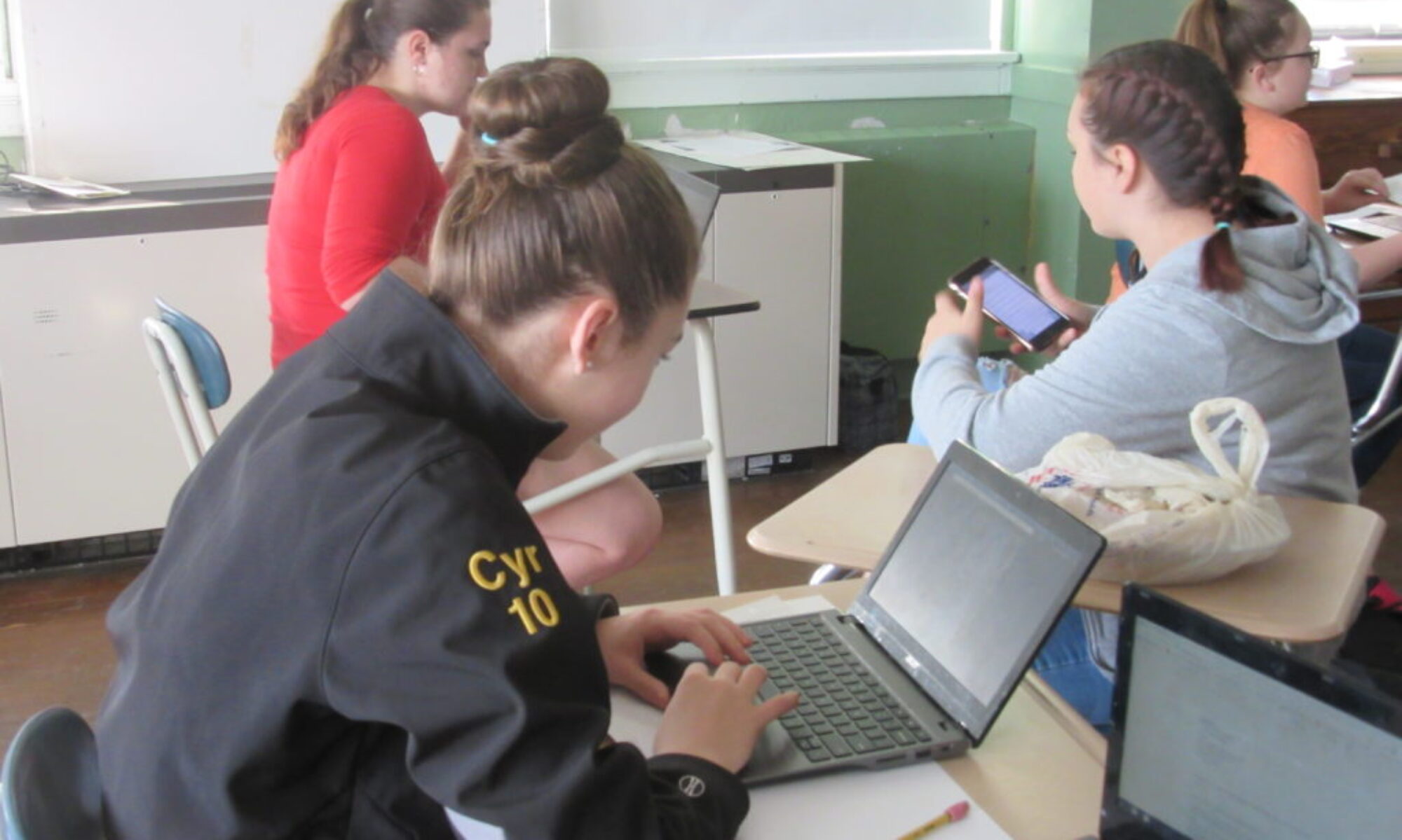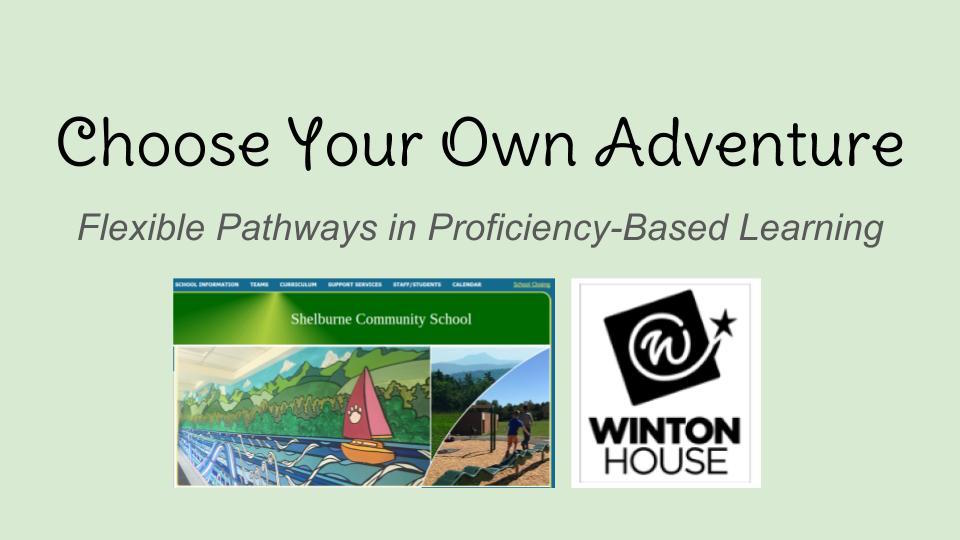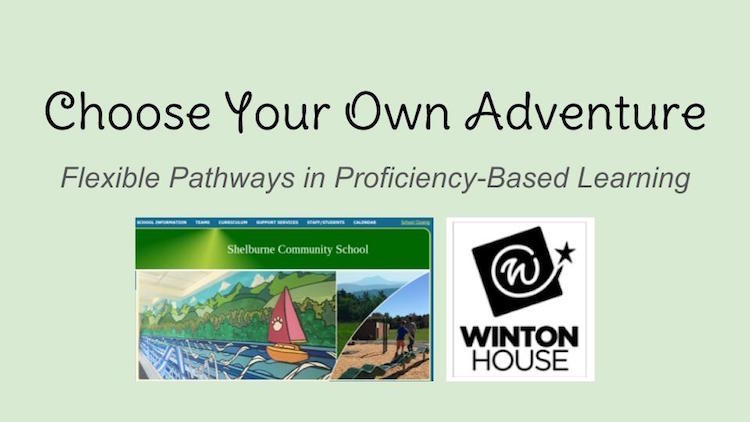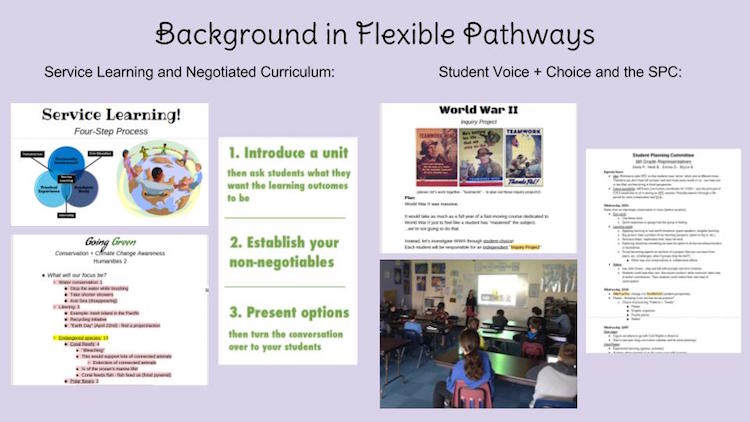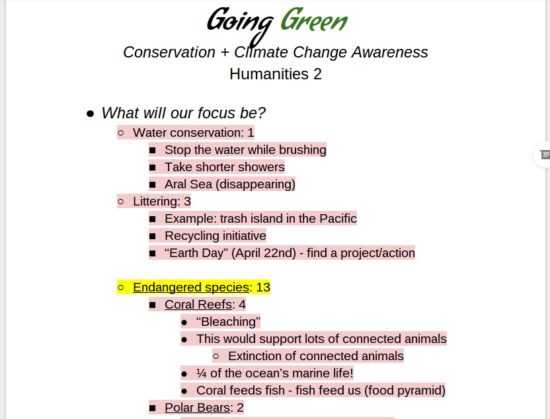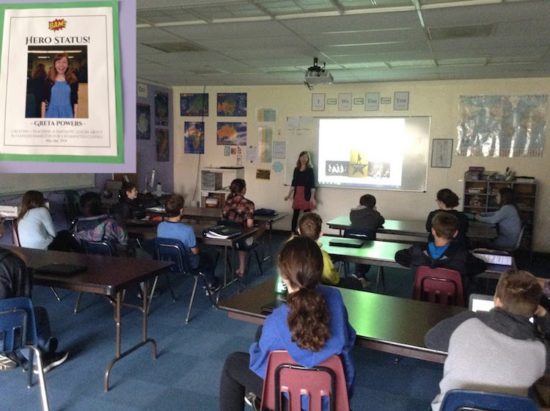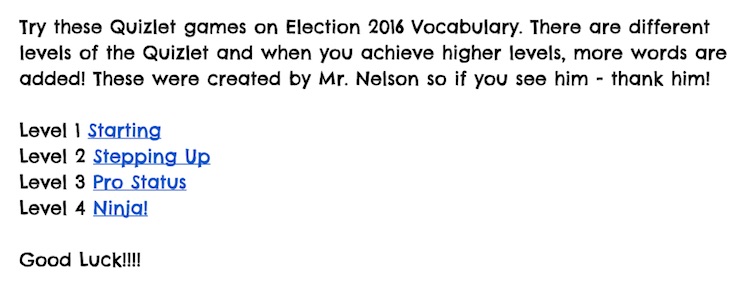Choose Your Own Adventure
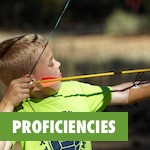 In Sam Nelson’s classroom, students choose what they learn, and how. Through the use of learning scales and targets, Nelson sets guidelines for students to demonstrate proficiencies in whatever they choose to study. Between the two systems — flexible pathways and proficiency-based learning — students negotiate a curriculum that keeps them engaged and satisfies their curiosity about the world around them.
In Sam Nelson’s classroom, students choose what they learn, and how. Through the use of learning scales and targets, Nelson sets guidelines for students to demonstrate proficiencies in whatever they choose to study. Between the two systems — flexible pathways and proficiency-based learning — students negotiate a curriculum that keeps them engaged and satisfies their curiosity about the world around them.
How does it all work? Let’s take a look.
Sam Nelson’s flexible pathways in proficiency-based learning
Social studies educator Sam Nelson shares how student choice and voice work in a classroom with flexible pathways in proficiency-based learning. He and his students talk about some of the structures that make it all work.

Originally presented at the 2017 Middle Grades Conference at the University of Vermont. A full transcript appears below.
Choose Your Own Adventure
Sam Nelson: Choose your own adventure. Probably a pretty familiar sounding theme, right? I’m talking about how I’ve been implementing pathways in proficiency-based learning, in my classroom over the last few years and in particular, what I found to be successful.
I’m honored to be an educator in Vermont. Act 77, as a law is, I think, nudging a lot of educators to be more progressive and take more healthy risks in our practice. So I’m thankful that it’s been a part of what has really, kind of, reinvented my practice over the last few years. That’s why we’re going to be talking about proficiency-based learning. We’re going to be talking about flexible pathways, and, we’ll be talking about how they worked this year, and even how we used them to address the election this fall.
Background on proficiency-based learning:
Again, keeping it short, it’s been quite a journey the past few years.
Three years ago, I was using the Vermont GEs (for those of you that remember those), and common core standards, and basing learning targets off of those.
And I was having a lot of grandiose failures in doing so.
But learning how learning targets can power the core of what you do, can work. Last year, I had moved to district learning targets within Social Studies — we called them inquiry skills for Social Studies. It was kind of a step in the right direction, but they were still very content-based.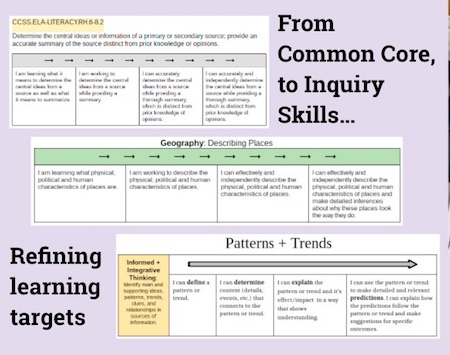
I became good at making learning targets and kind of slapping them on an assignment. That’s great and all: you feel like you’re communicating what the expectations are, but it’s not really enough. You’re not really helping students develop skills. Last year, I worked really hard at making the learning targets and the expectations connected to them very articulate, so I could put work in front of these students and say,
“Guys, it’s so clear what you have to do to be successful. I’m doing such a good job at supporting your growth.”
This year, I’ve had a lot of success in moving to true transferable skills.
My own evolution has been in kind of making those more articulate, but in practice, that’s where I’ve made a lot of strides.
All of them connected to our district’s transferable skills, the same transferable standards that Vermont’s putting out, around informed and integrated thinking, responsible citizenship, and self-direction.
What I found a lot of success with this year is actually practicing these skills, because it’s not enough to articulate them and make them look really pretty on learning targets. It’s to actually practice them as you explore content. The content doesn’t go anywhere, but practicing these transferable skills to cultivate growth, that’s what really leads to learning, it’s tangible and remarkable.
“You, We, Us, I.”
That might sound like some strange jargon, but really that model encapsulates what it’s like, this format of practicing.

- The You refers to this guy: me. When we look at a new skill, I’ll model the skill. Kind of showing what it means to get a one, two, three, or four on a learning target.
- The We, is when as a group, as a class, we would practice this skill. Nothing formal, nothing that goes in the books, but an opportunity to practice the skill and get some group feedback.
- The Us is usually more like partners or small groups, where they’re practicing, trying to refine their skill, which finally goes down to:
- The I. Each student does things for the independent summative grade that will be formally assessed.
Big picture with all this? One thing that I’ve taken away from my learning the last few years: more feedback, less grading.
By the time something’s actually assessed in a summative way, most of the students have had the chance to master it. Those that don’t will have more opportunities to do so, because these are yearlong, and in most cases, “middle school-long” transferable skills. The thing that changes is the complexity of the content to which we apply the skills.
Okay. That was really teachery. Should I move on?
Background on flexible pathways
Kind of the same story: a lot of bumps along the road, lot of mistakes made. Love that stuff! That’s called learning.
Over the past three years, I have found how successful it is when students have choice and voice in the curriculum and when you make curriculum a conversation, not a mandate.
Service learning is up there, because it really puts student choice, and wanting-to-connect-to-the-community-in-an-authentic-audience way at the core of what you do. And you have to be flexible, because it’s tough, it takes a lot of negotiation, and sometimes, even takes me getting into a little bit of trouble, in kind of connecting with the community members. All really good parts of learning.
Charting student-led discussions in Google Docs
This is just an example of how I love my role as a teacher, this Google Doc. I’m tracking the conversation, there’s a ton of student-led discussions — and I mean student-led, where I literally remove myself from the discussion, sit on the outskirts, and just track the discussion digitally, because I’m pretty quick on the keyboard. Even when the students struggle at times with conducting their own discussion and struggle with facilitation and talking over each other, it’s really incredibly powerful. Sometimes I sit back and let them struggle because they learn through that.
But what’s inspiring is that by the end of the year, they actually can’t wait for me to get out of the way, because they want to have just a student-led discussion. And again, I’m doing nothing but tracking it. When I come back to it, I’ve got kind of a log of their notes.
Connected to that, I mentioned student voice and choice are a huge part of this.
From having students design what an actual assessment is going to look like, to unit long student-designed curriculum, we kind of talk about what the overall themes are going to be, but then they help me design what we’re going to explore. What’s our learning going to look like? What’s the product of our learning going to look like? Again, always student-led, always tracked by me and really making it a conversation.
Here’s where a student actually asked me if she could teach a lesson.
I’m sure many of you are familiar with the fact that Hamilton: The Musical is taking over the country (which of course, as a Social Studies teacher, I’m so into). This student asked me, during our American Revolution unit, if she could do a lesson on Hamilton.
She taught every student on her whole team.
It was so inspiring! I got to sit in the back and be a student, and take pictures, and track what she did.
And then there’s the SPC: The Student Planning Committee.
The SPC is an acronym that stands for Student Planning Committee. Some of our panel members, they are on the sixth and seventh SPC. Totally a new thing that I’ve started this year, where we meet usually every week or at least every other week. We talk curriculum.
I told them up front, “Those that want to be a part of this, they volunteer. I told them what they’re getting into. At best, they might get a little bit of chocolate out of it, but there aren’t a lot of frills that go along with it.” But we meet and they help inform my instruction.
The thing I promised them, is that I wouldn’t sit them down, listen to their ideas, and say, “Guys, that’s so cute.” Then do nothing to change.
What flexible pathways & proficiencies look like in practice:
2016 Election Edition
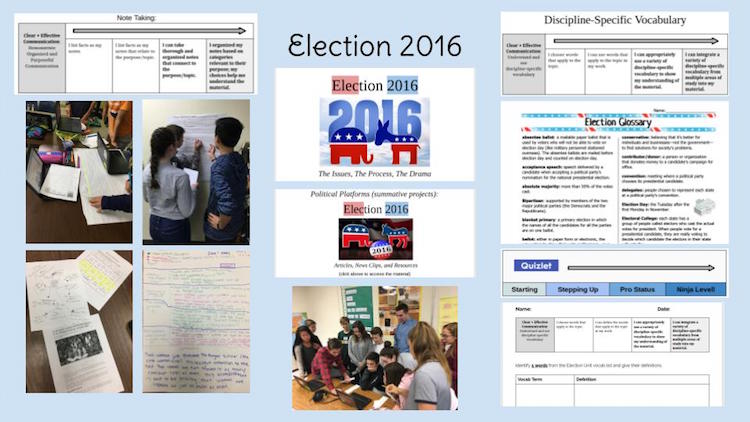
When we started the fall, as sixth, seventh and eighth graders at Shelburne Community School, we looked at the election.
I’m going to keep this brief, but you can see, we’ve got note taking:

and then we’ve got discipline-specific vocabulary:
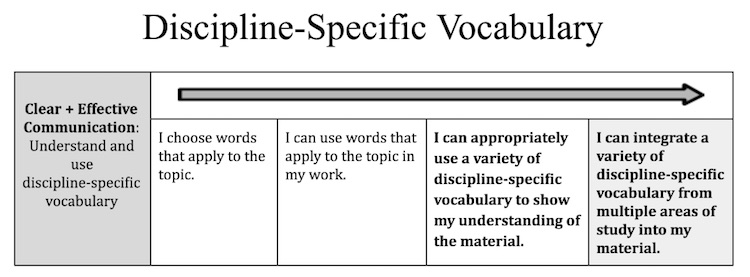
Those are the only two transferable skills that we actually practiced, in exploring the election and these students were graded in a formal summative manner.
In short, with note-taking the method of practice was again:
- You: me modeling the behavior
- We: giving them a resource where it shows different types of notes (because notes can look and take the shape of a lot of different things)
- Us: had them work in groups, giving each other feedback, and then
- I: having them practice.
We did note-taking bingo. We had a bingo board where there were different major issues connected to the election, like immigration, women’s rights, gun control. Students worked their way through a bingo board, and in doing so, students had to try all four of the note-taking strategies that we were looking at. All of that practice, all of it ungraded (but with a lot of really good feedback), meant that by the time students did their political platform, their projects, they had notes connected to the research. These students were all masters. It was really inspiring for me to see how successful everyone was in tracking notes and making them detailed in nuance and really insightful.
Discipline-specific vocabulary was similar: we had vocabulary if you rolled it out, practiced in a few ways before anything went into the books and even using tech tools, like Quizlet was fantastic.
Quizlet?
Quizlet’s an engaging and fun way to practice something like vocab, especially when it’s ungraded. It becomes more of a game-based learning thing: attach a score to it, keep a scoreboard going, and students don’t have to worry about bombing, and failing and having a nasty grade in the book that looks awful. Quizlet works nicely too in that you can set up four different levels, so you can kind of work your way up from Starting, to Stepping Up, then Pro Status is great, right through to Ninja level, for those of you that are really nailing it.
And students had to use that discipline-specific vocabulary in their political platform projects.
Those platform projects themselves? A lot of student voice and choice there. People made PSAs, infomercials, posters, people wrote letters, tons of different ways that they could basically express their understanding about major election issues. Super successful. The whole authentic audience piece? We connected with a different team at the school. Everyone on our team laid out their political platforms in a gallery, then we went over to where the other team’s were set up and then we had a little sheet, so there’s a little bit more of that authentic piece, and even simulating a little bit of the election.
As always, time became the challenge.
You Say You Want a Revolution
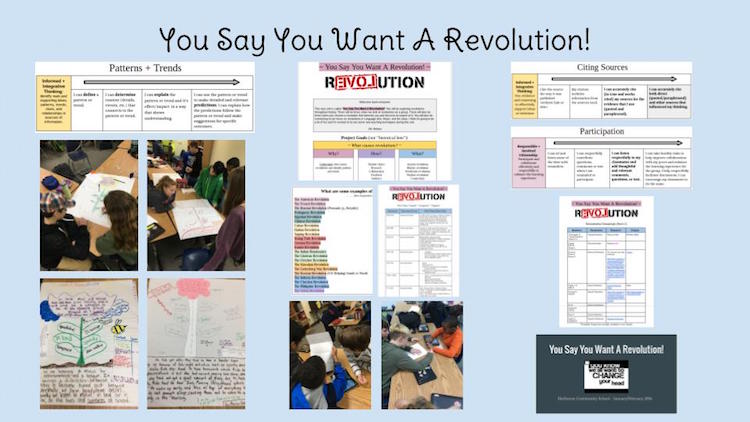
We’re going to talk about the other major unit that has kind of combined proficiency-based learning and flexible pathways: You say you want a revolution. Looking at revolutions through time.
Got some learning targets up here, Citing Sources:
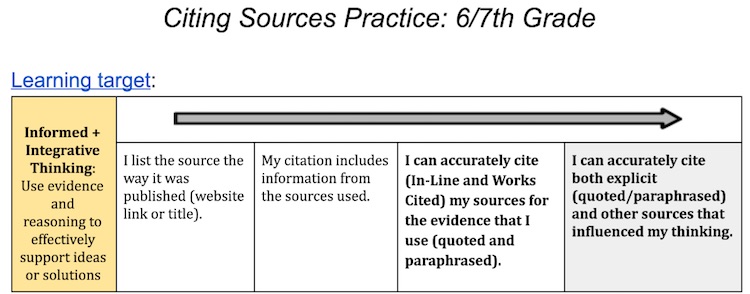
and Participation:

We also looked at patterns and trends.
Emma: “This is the flower that my group made:
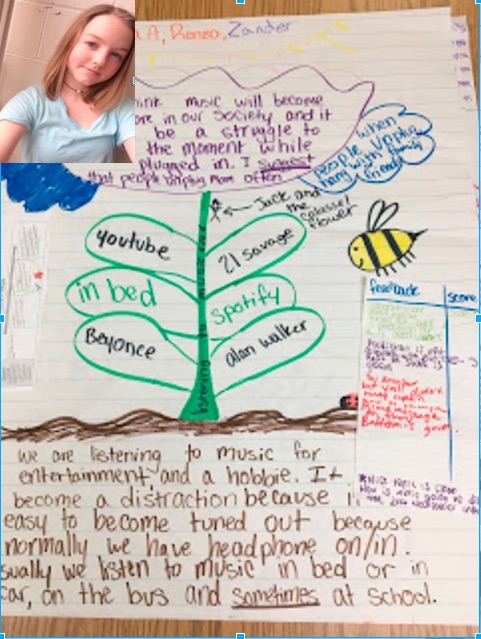
The stem was where you put in the trend. For us specifically, our trend was that every person in our group started gradually listening to more music since the beginning of the school year.
We specified in each of the leaves the patterns. Each of us put in who we listened to, and how we listened to it.
Then the dirt or, nutrients, was put in what you do and maybe what some of the not-so-great things about it are, so looking at it from both sides. Some of ours were; it helps us relate, it’s a hobby, entertainment and sometimes, for at least myself, it helps relieve stress. Just when you’re having a hard time, just listen to music. Then some of the things that were not so great, is that you plug in headphones and you tune yourself out.
Then the top is just what your prediction is. What you think might happen. Our prediction was: music’s going to become more involved in our society.
Then you say, “I suggest this.” to some people. I used, “Suggest unplugging more often.” Or even listen to music without headphones, with a group of friends, or at a school dance, listen to music with a group of people, so you’re not plugged in because you’re with people doing it and in the world at the same time.”
Sam Nelson: Thanks Emma. Each step in the flower project is one step on the learning target. You can’t get a more tangible and clear look at what it means to be a one, two, three or four on this Patterns and Trends learning target. And again, some people kind of failed on this one, but it was the You, it was the We. It was in a group and we’ll be practicing again, moving toward independence.
Helpful Resources
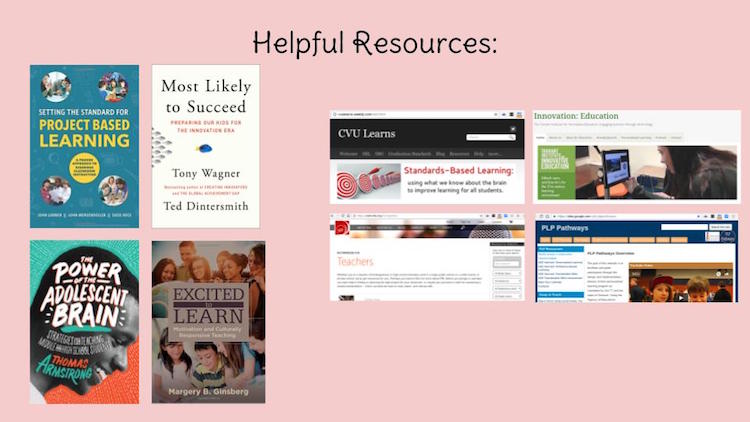
Some of this might look really familiar, but there’s the project-based learning book, Power of the Adolescent Brain by Thomas Armstrong. It’s unbelievable, totally into the brain-based learning piece. Very inspiring when you think about how you want to roll out content to these guys. The Excited to Learn book by Margery Ginsberg, was kind of what inspired me to bring on the SPC. That Student Planning Committee. Again, having them that connected, that closely connected to what we’re doing is so helpful. I’m never not going to have that again. Then, of course:
Okay, there’s your plug. There it is.
Q & A with Students
Mr Nelson handed over the presentation to his students, who fielded questions from the audience.
How has this type of learning changed your relationship with school? Seems like you all are like super excited about what you’re doing, and being in class, and even coming here. How do you feel about school now, differently than maybe previously?
Abby: I guess, I think it’s easier, instead of just handing you work and saying, “Here are the targets. Do it.” It’s easier when he kind of shows a little more example how to do it and we kind of work together as a class to kind of learn more about it and ease our way in and kind of go off on our own and do it. Instead of just handing the work and saying, “Do it.”
Sophia: Just building off that, I definitely enjoy a choice too. To be able to create something that’s not just a specific your answer and questions, or something like that. You’re creating something that’s more unique.
Rory: For me, I like the standards-based learning more, because before when we would take tests and stuff, if we would have a question for a teacher, they really couldn’t answer it, because they’re like, “Well, how do I answer this without giving you, telling you what to do?” With the standards, it makes it a lot clearer what you have to do because it pretty much tells you exactly how to do it step by step and then you just pretty much have to do the work.
It sounds like you guys are less stressed out when summatives come along.
Rory: Yeah.
Abby: I think the hard thing is that I know a lot of people that will try to connect a grade average to a standard. Oh, yeah three is 85 to 75, or 75 to 85. That’s not really how it works. That can get really hard to try and explain. Like a mom saying, “Oh yeah. You only got a two. What’s wrong? You can get up to a four.” But that means you just need one more practice before you take the summative. You need one more practice and then you can get the three, or potentially even the four. The four is you’re exceeding. You understand it, so you can do it whenever to any topic.
Gabriel: Yeah. Like with making a learning target, it also just makes it a lot easier, because you have so much time in your practice and you’re a lot more ready for the summative than you would be if you had it right at the unit.
When you’re doing the We part of a unit, and you’re presenting something like a revolution, do you first study a specific revolution together? Or do you get a list of starting points? Can you can you guys pick anything you want?
Abby: I think, it kind of depends on the unit. For revolutions, we started off trying to name all the revolutions off the top of our head. Then we did a little bit of research, like the timeframe and a few small details about it. And we made one big class list. We were split up into small groups and each group had to research a couple revolutions and then from that list, we got to choose which revolution we’d like to study as a group. And then now, we’re going into the patterns and trends part of it.
The SPC, the committee that helps the curriculum, can you talk about how those meetings work? And what voice you give?
Emma: We kind of… Mr. Nelson generally has some sort of agenda that we don’t stick to, but he’s got some ideas for projects or stuff, and then we discuss it and say what we agree with and what we disagree with. But sometimes, also if there’s something that he’s doing that we don’t like, we’re going to be like, “You’re boring us with this. Please, can we change it and do something else?” Generally, we have some sort of ideas.

